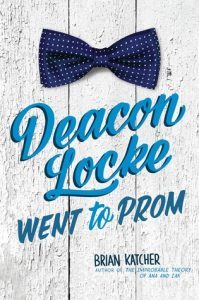Kathy Lynn Emerson's Blog, page 43
May 25, 2017
May 25th
Jessie: Traipsing about somewhere in the U.K.
 Right about now I am likely in Scotland visiting one of my kids who is just finishing up a semester abroad. Because this post was written several days before I left I cannot say for any certainty exactly where I am or what I’m up to. What I can say for sure is that there are several holidays listed on the web for May 25 that I found intriguing.
Right about now I am likely in Scotland visiting one of my kids who is just finishing up a semester abroad. Because this post was written several days before I left I cannot say for any certainty exactly where I am or what I’m up to. What I can say for sure is that there are several holidays listed on the web for May 25 that I found intriguing.
For instance, May 25 is National Wine Day, not to be confused with National Drink Wine Day, which occurs on February 18. May 25 is also National Tap Dancing Day. I think it more likely that I would participate in tap dancing if I had also taken part in some wine drinking. It’s alsoNational Brown Bag It Day. I suppose that it could apply to discreetly packaging wine bottles as well as to transporting healthy lunches.
It’s also National Red Nose Day, sponsored by Walgreens. Before I looked it up I thought it must refer to allergies, colds or even the side effects of making every day National Wine Day. I was wrong. It is a day for raising money for charity, especially for impoverished children.
and lastly, here in the UK, it is National Towel Day. This day celebrates the work of author Douglas Adams best known for The Hitchhikers Guide to the Galaxy. the holiday was started in 2001 just after Adams’s death as a way to celebrate his work. Apparently people are encouraged to carry towels about with them wherever they go on that day because you never know when a towel will come in handy. If you see Instagram photos of me carrying a towel you will know why!
Readers, what is your favorite silly holiday Writers if after your death your fans were to make a special holiday to celebrate your work what would you like it to be?
May 24, 2017
Whitey and Me
Joe Souza: I never met Whitey Bulger growing up. I’m not sure that I ever wanted to meet him, but I was certainly intrigued by the legend of the man. The truth is, Whitey Bulger is as responsible for my foray into crime writing as anyone. I write this post not to praise him but as a way of reflecting back on my views of the man at the time. It was a time in my life when I was an impressionable young man making my way in the world.
I never met Whitey Bulger, despite the fact that I worked in Southie for seven years while he reigned terror in Boston. Despite the fact that I drove past his grimy headquarters (Triple O’s tavern) on a daily basis. Despite the fact that Whitey lived in a condo in my hometown (Quincy) and commuted over the Neponset Bridge each day to conduct his criminal activities. Despite the fact my mother grew up with him in the same building in the Mary Ellen McCormack housing project. (As a side note, my father grew up in Roxbury with Whitey’s murderous partner, Stevie Flemmi). Or that Whitey executed Brian Halloran a quarter mile from the fish pier where I worked.
he reigned terror in Boston. Despite the fact that I drove past his grimy headquarters (Triple O’s tavern) on a daily basis. Despite the fact that Whitey lived in a condo in my hometown (Quincy) and commuted over the Neponset Bridge each day to conduct his criminal activities. Despite the fact my mother grew up with him in the same building in the Mary Ellen McCormack housing project. (As a side note, my father grew up in Roxbury with Whitey’s murderous partner, Stevie Flemmi). Or that Whitey executed Brian Halloran a quarter mile from the fish pier where I worked.
 There were plenty of people on the waterfront who knew Whitey: small time criminals, union men, cops and politicians, In many ways, I felt as if I was one degree removed from ‘Jimmy’ Bulger (I’d always been warned that if I ever met him to never to call him Whitey to his face). I braced for the day when I might accidentally run into him on the street or in one of the local bars. What would I do? What would I say? I certainly wouldn’t say or do anything disrespectful to Boston’s most infamous and dangerous mobster. Whitey was like a VIP in town, respected and feared by many who lived in Southie. People viewed the guy as if he was a celebrity.
There were plenty of people on the waterfront who knew Whitey: small time criminals, union men, cops and politicians, In many ways, I felt as if I was one degree removed from ‘Jimmy’ Bulger (I’d always been warned that if I ever met him to never to call him Whitey to his face). I braced for the day when I might accidentally run into him on the street or in one of the local bars. What would I do? What would I say? I certainly wouldn’t say or do anything disrespectful to Boston’s most infamous and dangerous mobster. Whitey was like a VIP in town, respected and feared by many who lived in Southie. People viewed the guy as if he was a celebrity.
South Boston was largely blue collar and proudly provincial back then. Everyone worshipped our celebrities, especially if they were one of us. Sox, Celtics and Bruins. My mother loved the Kennedys, despite all their faults, and you couldn’t convince her otherwise. Priests were treated as demigods and practically idolized by parishioners. This sense of entitlement facilitated the sexual abuse in the Church that scandalized the nation. In some ways, it also helped Whitey Bulger rise to power. People just looked the other way.
To say that I was fascinated with Whitey Bulger as a young man is an understatement. His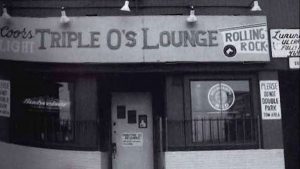 brother, Billy, was the most powerful and feared politician in the state. For many years he lorded over the Massachusetts Senate as President and dictator. He was a triple eagle: BC High, BC. And then BC Law. He was the proud son of South Boston. If you worked for the state and ended up on his bad side, he’d withhold your salary until you won back his favor. Or else he’d find a way to get rid of you. A state cop who once arrested Whitey found himself relieved of his duties a year later. Shortly after that he killed himself. So while Billy was the most important and powerful politician in the state, Whitey ruled the underworld with his unspoken blessing. Together they made a formidable pair.
brother, Billy, was the most powerful and feared politician in the state. For many years he lorded over the Massachusetts Senate as President and dictator. He was a triple eagle: BC High, BC. And then BC Law. He was the proud son of South Boston. If you worked for the state and ended up on his bad side, he’d withhold your salary until you won back his favor. Or else he’d find a way to get rid of you. A state cop who once arrested Whitey found himself relieved of his duties a year later. Shortly after that he killed himself. So while Billy was the most important and powerful politician in the state, Whitey ruled the underworld with his unspoken blessing. Together they made a formidable pair.
We all believed Whitey was Robin Hood. This was the myth passed down on the street and in the newspapers like the Boston Globe. Everyone believed that Whitey took care of his own. Watched out for the poor and and bought groceries for the old widows who lived on K Street. That he purposefully kept drugs out of Southie was one of the biggest lies, but many believed it at the time, despite kids dying everyday from heroin that he profited from. It was all part of the myth perpetuated to grow his legend, and most people bought into this perception of him. Famed Globe sportswriter Will McDonough befriended ‘Jimmy’ and reported about him in a positive light. And Salon called disgraced columnist Mike Barnicle, “The best friend a gangster could have.”
So what’s a nineteen year-old kid to think when reading all of this? This view of Bulger was ubiquitous in the neighborhood, establishing his image as a hometown hero. Men talked proudly of him over beers at the Eire Pub. He was a proud Irish-American like one of us. While the Angiulo family fell away, thanks to his secret cooperation with the FBI, Whitey continued to remain in power. Everyone admired the fact that Whitey was smarter and more clever than the Italian mobsters. Whitey was a staunch supporter of the Irish Republican Army as they fought to break away from the Brits, and this endeared him to the Irish-American community. Whitey didn’t drink or do drugs, keeping himself fit by lifting weights and exercising religiously. He was an avid student of history and loved to read books. How could anyone not admire this warrior/philosopher from the mean streets of South Boston?
In retrospect, I look back and think what a fool I’d been for buying into such nonsense. Whitey was a lowlife who not only killed his way to the top, but ratted out all his competition in exchange for FBI immunity. The agent handling him (John Connolly) grew up in the neighborhood and worshiped the Bulger brothers. One of his best days, according to Connolly, was when Whitey bought him an ice cream cone when he was a kid. Not only did he pass on top security information to Whitey, but he watched on as Bulger killed his rivals and maintained his iron tight grip on the rackets.
Looking back on those days, and my obvious blind spot, I find myself more intrigued than ever with Whitey’s climb to the top. But for different reasons. He’s a vile human being and deserving of no sympathy. But as a crime writer, I can’t help but be fascinated by his violent career. The utter ruthlessness of his character is chilling, and the criminal skill set he possessed was unparalleled in modern mob history. In the corporate world, he might have become a Rockefeller, Lee Iacocca or Steve Jobs. Whitey could charm you one minute and then gun you down the next without any remorse. Even the FBI agent handling him, John Connolly, fell deeply under his spell. Thankfully, Connolly is now spending the rest of his life in prison.
I never met Whitey Bulger and I’m glad I didn’t, but he’s stayed in my head all these years. As a writer, I doubt I could devise a believable character as fierce, cunning and charismatic. And what are the odds that his brother’s political career rivaled Whitey’s own meteoric rise in the underworld? Good brother. Bad brother. Classic literary theme, right? Tight knit Irish brothers watching each other’s back.
As writers, we have a responsibility not only to tell a great story, but to deconstruct myths and illuminate universal truths. The old Boston crime writer, George V. Higgins, was the best at depicting crime’s influence on society. If you’re a crime writer and you haven’t read V. Higgins, you definitely should. His dialogue heavy novels perfectly catches the zeitgeist of the Boston crime scene in the seventies and eighties.
Looking back on those days, I can clearly see how destructive unchecked power is to a democratic society. Only by exposing such truths in our writing will we have any chance of preventing future Whitey Bulgers. “Power tends to corrupt,” said John Acton, “and absolute power corrupts absolutely.” It’s something we must teach our children.
My hope is that future generations will never see Whitey Bulger as anything but a monster. In many ways, the institutions that rose up in Boston allowed such unchecked criminal behavior to happen. It’s also the reason Roman Catholic priests got away with sexually abusing children for many years. As an altar boy during that period, serving with a priest who was later convicted of such a crime, I’m glad I came out unscathed. I can’t deny the powerful influence these factors had on me growing up, and on my writing. I’m just relieved to know that Jimmy Bulger will be spending his remaining days behind bars. I pray he lives a long life before he meets his maker.
May 22, 2017
Will Illness Change a Relationship? Yes — and No
Lea Wait, here. On February 1 of last year I wrote on this site about the stroke my husband, Bob Thomas, had suffered the week before. I didn’t mention that we’d also just found out he had other medical issues: congestive heart failure and COPD/Emphysema. And — oh, yes — peripheral artery disease and severe anemia.

Bob Thomas, Lea’s husband
A number of people have asked me recently, “How is Bob? How are you both doing?” Here’s our answer.
2016 was a rocky year. Not for our relationship – that might even have strengthened – but for understanding Bob’s physical challenges and knowing what could be improved, what couldn’t, and accepting both.
I’d be lying if I didn’t say some tears, anger and depression were involved. For both of us.
Now, almost exactly 18 months later, Bob’s doing well. Yes, he now uses the stairlift and ramps in our house, and wears clothes that are easier to manage than those he used to wear. Yes, he tires easily. But he hasn’t been hospitalized since last September, and that was just for blood transfusions and infusions of magnesium to counteract the anemia. Minor hospitalizations.
But our lives have changed. For example, Bob used to do most of the errands at our house, since he likes to get “out in the world,” while I’d rather be a stay-at-home introvert. On good days (like the day I’m writing this!) he still does those things.

One of Bob’s Paintings
But on other days, I’m the one who’s out doing errands. That’s hard for both of us. I don’t do as much writing, and Bob feels constrained. But we agree he needs to save his strength for activities he values most — painting, and cheering the Celtics on from our living room.
He has a major exhibition at the Southport Library in Maine this month and next, and has other paintings on display at the Stable Gallery in Damariscotta. His work is becoming even more sophisticated and layered. On rough days he worries about how long he’ll have the strength to paint, and whether he can improve further.
Bob takes about thirty pills twice a day to keep his illnesses at bay. The most challenging and troublesome now is his stage 3 COPD, for which he uses a nebulizer every 3-4 hours, around the clock, in addition to 2 other inhalers. At some point, perhaps not too far off, he’ll need to use oxygen.
Because of his breathing problems, Bob and I have not shared a bedroom for six months. Neither of us like that, but it’s healthier for both of us. We both need sleep, but our sleep is often on different schedules. And if Bob got a cold, he could end up in the hospital. I keep any germs I’ve acquired down the hall. I’m not far away if I’m needed. Which I am sometimes, for various reasons.

Another of his paintings
Bob and I still see friends and attend art openings and author talks, although we don’t stay as long as we used to. We try to keep calm (not easy these days, for an assortment of reasons!) Anger and stress make COPD worse. Will it get better? No. But maybe we can delay its progress a little.
People have asked me how I’m coping. Physically, I’m fine. Emotionally, like Bob, I have good and bad days. I sometimes feel guilty for taking time away from him to write, but I have deadlines, and we have bills. I’m limiting my appearances, and only doing two or three events this year that require me to be away from home overnight.

The road we live on, turning, but continuing on
We are both trying to focus on today, not on yesterday or tomorrow, and on the time we have together.
So, in answer to the question at the top of this post: yes, our daily lives have changed since Bob was diagnosed with what he often jokingly refers to as his “three fatal illnesses”. But, no, nothing has changed. We still love each other, want the best for each other, and try to manage our lives so we have time to continue what we love: painting, writing, and being together.
For now, we’re planning to enjoy warm weather and sitting on our porch and talking with friends and celebrating our life together.
Illness doesn’t change love.
Note: Bob read this and encouraged me to post it.
May 21, 2017
Beta Readers: Where to Find Them, How to Use Them, and Why You Need Them
I’ve been thinking a lot recently about my own writing process, as I slog away on the next Flint K-9 Search and Rescue novel. One of the most important parts of that process is one I actually have very little to do with – it’s the moment when I hand my manuscript off to objective third parties for feedback. Thinking about that brought me to this piece I originally wrote for my editing blog back a couple of years ago, and it seemed to me the information might be helpful for other writers who enjoy the Maine Crime Writers blog.
For writers, a thoughtful beta reader is worth his or her weight in gold. Before ever handing your manuscript off to an editor, a qualified beta can let you know about plot holes, character inconsistencies, slow pacing, and any number of other big-picture issues you may have missed during the self-editing phase. Since betas are so crucial to the writing process, it made sense to me to devote a post on this most blessed invention.
What is a beta reader?
There are professional beta readers, and there are unpaid betas. In either case, the beta reader is ideally someone who (1) Knows your genre, (2) Is an active rather than passive reader (questions the texts, notes plot holes, etc.), and (3) Is able to identify problem areas and communicate them clearly to you, the author.
When is my novel ready for a beta read?
Beta readers aren’t there for your first draft, or your novel-in-development — save that for your writing group. Your manuscript should be complete, proofread to the best of your ability, and you should have gone through at least a couple of rewrites to ensure that the work you’re sending them is actually a coherent story with a beginning, middle, and end. Think of it in terms of making a piece of furniture. If your manuscript were a table, it should have a top, four legs, no nails sticking out, and should be recognizable as the table it will ultimately be. It doesn’t have to be varnished or even necessarily sanded down, but you shouldn’t send it to your beta with two legs and a jagged splinter hanging off the side.
Where do I find beta readers?
If you belong to a writing group, you can frequently call on members of that group as beta readers. Websites like the World Literary Cafe, Writer’s Digest, or Goodreads also have areas designed specifically for authors seeking betas. If you decide you need a professional beta reader, many editors offer the service, or can refer you to someone who does.
When should I pay someone for beta reading?
If you have a novel that you believe has significant structural issues, a professional beta reader can help pinpoint what those issues are and help you address them. When hired to beta read at Adian, I provide a complete written summary and analysis of all aspects of the story, breaking down areas that could use improvement and providing suggestions for revision. While it is not a content edit, a writer receives much of the same feedback (without the benefit of receiving a line-by-line edited manuscript at the end of the job) for a fraction of the cost.
When I give my beta reader my manuscript, should I ask specific questions before they begin?
This depends on your reader. Some betas want a list of questions, while others prefer to read the manuscript cold and note any questions or concerns that arise that way. Unless the beta specifically says he or she does not want any questions first, I do recommend giving a quick rundown of some of your areas of concern. If you’re particularly worried about pacing, character development, dialogue, etc., give your beta a heads-up. Personally, my preference is to have as much information as possible regarding the author’s concerns.
How long should it take for my beta to finish reading?
If you’ve hired a professional, you should come up with a timeline beforehand so that you know when you can expect to hear from your reader. If you’re relying on someone who offers the service for free, or you’re trading beta reads with a fellow author, tell them up front what your timeline and publishing schedule looks like. Do recognize that this is a time investment for them, and act accordingly. Say thank you. Don’t nag while they’re reading. If something comes up and they’re unable to meet your deadline (with the exception of the paid beta, of course), try to understand their perspective and work with them to come up with a new timeline.
What happens after my beta has finished reading?
Take a little time to digest what feedback the beta has provided. Just a note: Criticism — even constructive criticism — can be hard to take, but resist the urge to try and explain or defend yourself in response to every comment made. Always keep in mind that you won’t have the opportunity to explain your choices to your readers; your beta(s) give you a great chance for an intimate look into what many of your readers’ thoughts and reactions will be. Rather than be defensive, be grateful for this opportunity from people who aren’t passing judgment — they’re trying to help you make your novel better, not tear it (or you) apart.
If you didn’t provide pointed questions before, now is the time for them. After you’ve had some time to process the suggestions and feedback given, look through your questions to determine what hasn’t been addressed yet. Start coming up with a plan of attack. The notes should give you some direction in terms of how to make your next revisions. If they don’t, ask your beta: What would you do to make this a better novel? How long did it take before you were invested in the story? Were there points when your interest lagged? Was the ending satisfying? If not, why? If they loved it, what did they love about it?
<><><>
Whether your goal is to have your novel traditionally published or you plan to do so on your own, the value of a communicative, thoughtful critical reader is integral. Work on honing this skill in your own reading, and you’ll find that it not only helps you assist other writers, but will become invaluable in judging and refining your own work.
Jen Blood is author of the USA Today-bestselling Erin Solomon mysteries and the Flint K-9 Search and Rescue mysteries. You can learn more about her work at www.jenblood.com.
May 19, 2017
Weekend Update: May 20-21, 2017
 Next week at Maine Crime Writers, there will be posts by Jen Blood (Monday), Lea Wait (Tuesday), Joe Souza (Wednesday), Jessie Crockett (Thursday), and Kate Flora (Friday).
Next week at Maine Crime Writers, there will be posts by Jen Blood (Monday), Lea Wait (Tuesday), Joe Souza (Wednesday), Jessie Crockett (Thursday), and Kate Flora (Friday).
In the news department, here’s what’s happening with some of us who blog regularly at Maine Crime Writers:
From Kaitlyn Dunnett/Kathy Lynn Emerson: The Goodreads giveaway my short story collection, Different Times, Different Crimes (https://www.goodreads.com/giveaway/show/235672-different-times-different-crimes) ends May 23. Up for grabs are five autographed copies of this trade paperback containing thirteen stories, three of them previously unpublished.
Kate Flora: If you happen to read this early enough on Saturday, Roger Gray and I will be at the Newport Cultural Center in Newport, Maine this Saturday at 11:00 a.m. to talk about A Good Man with a Dog, Roger’s memoir, finalist for the Maine Literary Awards.
On Sunday, Maine Crime Writers Maureen Milliken, Brenda Buchanan, and Kate Flora will be participating is Sisters in Crime’s Murder by the Minute at the Curtis Library in Brunswick. The event is from 1-3 p.m. and authors will be reading from their work. We’ll be joined by Gayle Lynds, Gin Mackey and Kate Cone.
And a reminder: Some lucky commenter is going to win a bag of books and Maine goodies. It could be you, so keep those comments coming.
In case you missed it, we’re thrilled that Maine Crime Writers Dick Cass and Kate Flora are finalists for the Maine Literary Award. The awards ceremony, also a fun Maine literary event, will be at the Space Gallery in Portland on June 1st.
An invitation to readers of this blog: Do you have news relating to Maine, Crime, or Writing? We’d love to hear from you. Just comment below to share.
And a reminder: If your library, school, or organization is looking for a speaker, we are often available to talk about the writing process, research, where we get our ideas, and other mysteries of the business. Contact Kate Flora
May 18, 2017
What Platform Do You Write On?

Vaughn
I am nearing the completion of a novel in a new series and my desktop computer crashed (not to worry, I worked in hi-tech for more than thirty years and I leave nothing of any importance on a hard drive) and I immediately set out to look for a new one. If there is any company on this planet that I hate more than Microsoft I don’t know what it is. I have had my fill of them constantly changing their operating system (I believe they should have stopped at Windows 7) and I abhor both Windows 8 and 10.
I looked at Apple products as well as computers running a Linux O. S. I came to the conclusion that Apple and the Linux companies must love their products and want to keep them because they price them so high that I cannot afford them. I ended up buying a new desktop running Windows 10 and when I went to reload my software, realized that I had purchased Office 2013, but it was delivered via download (have any of you tried to download Office using HughesNet or any other metered network–a metered network is one in which you are allowed a certain amount of bandwidth and if you exceed it your internet access will slow down do something lit one bit per hour–unless you contact your provided and pay for additional bandwith, usually something like $10.00 for an additional gigabyte. When I initially purchased Office 2013 I was a subscriber to HughesNet and the package download ate up all of my bandwidth before it had recieved one quarter of the program. This forced me to take my computer, monitor and keyboard to a friend’s house to download it via their subscriber. Even though I am now on an unmetered network, I was not about to purchase Office again. I opted to down load OpenOffice instead. OpenOffice is a robust program that is available at no charge from OpenOffice.org. It contains a word processing package (which will allow you to save your files in a number of formats–including .doc and.docx for Word), a spreadsheet, a powerpoint-like package, and several other useful programs.
I have a mini-office set up in my bedroom and I use my laptop in there. This led to my next problem. After a couple of weeks on the laptop with my head angled forward so I could see the screen, I developed severe neck pain with led to a visit to the emergency room. Diagnosis: arthritis (or arthur-itis up here in the county). Remedy: Keep my head up, especially when writing, some anti-inflammatory medication, and a recommendation for physical therapy. This led me to purchase a new HP All-In-One which has an elevated monitor which allows me to keep my head up while writing. Again I was up against the word processor issue. I knew there were a number of resolutions but the three that made the most sense were:
Word: I’ve already ranted about Microsoft, but the publishing industry (at least my publisher) requires all manuscripts be submitted in Word format. I did however,check out their Office products, while they do sell a home and student version of Office 2016 for $149.00, they are offering is Office 365 Home at $9.99 per month or $99.99 for a year with automatic renewal ($6.99 and $69.99 for Personal). I prefer to pay for my software once and not monthly or annually (Microsoft was making billions before it came up with this pay by month scheme).
Open Office: Again covered above and available at http://www.openoffice.org. Open Office does not have an equivalent to Outlook, however you can do an internet search for Eudora OSE (also open source) to fill that need.
Scrivener: A stand alone writing software available from Literature & Latte for $40.00. This is a terrific package that allows a writer to plan, develop characters, and write, both fiction and non-fiction. The problem, once you finish writing your book it has to be compiled into some form of word processor. My experience is that even if you save this in Word (,doc or ,docx) you need a copy of Word because there are things that will not compile in the manner you may desire (I avoid this by doing a chapter by chapter cut and paste into my word processing document). Other formats including .odt for Open Office are available.
I do, however, have to say that as much as I hate Microsoft, it beats my old Smith-Corona typewriter. Oh, yeah, I went with Open Office 4.1.3 and Scrivener. I’ll use my trusty laptop to check the fidelity of my documents when I convert them to Word for my publisher.
May 17, 2017
All in a Day’s Drive
Dorothy Cannell: Had a wonderful Malice Domestic spending time with old friends and  hopefully making new ones. My husband Julian and I set off in the car 5 AM on Thursday, April 27th. We always leave at that inhumane hour so if traffic is relatively merciful we can fetch up in Bethesda by 5 PM. Why don’t we fly instead? Julian’s reply has remained the same over the years: “It gives us time alone.” This made sense when we had four children, but now that it’s just the two of us humans at home it doesn’t pass the credibility test and has to be hurtful to our dogs Teddy and Watson.
hopefully making new ones. My husband Julian and I set off in the car 5 AM on Thursday, April 27th. We always leave at that inhumane hour so if traffic is relatively merciful we can fetch up in Bethesda by 5 PM. Why don’t we fly instead? Julian’s reply has remained the same over the years: “It gives us time alone.” This made sense when we had four children, but now that it’s just the two of us humans at home it doesn’t pass the credibility test and has to be hurtful to our dogs Teddy and Watson.
The truth is Julian finds the mammoth drive emotionally fulfilling, especially when mentioning it to our sons, both of whom wilt at the thought. When talking to people at Malice who have driven in from Pennsylvania or New York, he gets a self-deprecating smirk on his face. Unbecoming, but we all have our small vanities. A more convincing response would be that it provides Dorothy with a great environment for working.
No, I don’t pound away on as laptop as the miles slip by under the wheels, but I do some scribbling, usually on whatever scrap of paper I can root out from the bottom of my purse. More often than not a Hannaford’s shopping receipt. My creative source – highway exit road signs. A few years ago I noted one for Lamorna and thought great first name for a female character. And so came Lamorna Blake, a beautiful but vapid young woman in Murder at Mullings.
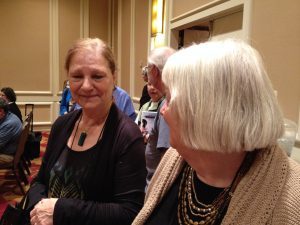
Dorothy and Margaret Maron at Malice Domestic
Here are some of my name notes from this trip and the images they provoked:
Havre de Grace – readily converts to Grace de Havre, an aristocratic woman struggling to maintain the appearance of wealth.
Rochele Pelham – attractive career titian haired woman.
Leona Teaneck – a tall, thin middle aged woman lacking a sense of humor.
Perth Amboy – a short, rotund young man wearing round gold rimmed glasses.
Hackensack – last name of a tall, rangy, bookish man.
I also, though less frequently, pluck out names for places. On this occasion I also noted:
Churchman’s Crossing – area on the outskirts of a village. Picture body found in a car on the verge.
Larchmont – a large country house with lovely gardens, possibly home of Perth Amboy.
Best,
Dorothy
A Shout-Out and Thoughts on a New Trend
It isn’t until Deacon confides in his witty and outgoing best friend Jean that he realizes she could be a great person to take. Only problem is Jean isn’t your typical prom date. She’s older. A lot older. And she’s Deacon’s grandmother.
But when Deacon meets Soraya—a girl unlike any other he’s ever met—he fears he has totally squandered his chances of having a prom he’ll never forget. Deacon couldn’t be more wrong. About everything.“
By now regular readers of the MCW blog know I’m a voracious reader and book reviewer (125 thus far in 2017). Part of that world involves getting newsletters from a lot of authors, spanning the young adult, mystery, paranormal, romance and new adult genres. Earlier this year, something happened and I’m still not sure how it will affect the world of literature/publishing. Authors started banding together and offering three things to readers: Contests to win books, Kindles and Amazon gift cards, free ebooks and dirt cheap ebooks.
My take thus far is twofold. First, it’s a bonanza for readers and second, it’s a glorious failure for the authors. Why it’s a bonanza for readers should be obvious. Free is really good, a full length book for $.99 is good, but some authors and groups of authors have gone a step further, they’re putting together box sets of up to twenty ebooks for that same 99 cent price.
There some fairly big gotchas in this new movement, however. #1-when you sign up for most of these giveaways, you’re agreeing to be put on multiple author newsletters (sometimes in excess of thirty) and some of them pump out at least a couple per week. Granted, you usually get a free ebook out of the deal, but one can only read so many books, even when retired. Most expect you to post a review which is fair, but when you get hit with twenty new books a week and you already have a TBR stash, it’s not easy staying abreast of the bounty.
Another red flag I’m seeing more frequently as I read these newsletters is how casually authors talk about churning out multiple books in a year (sometimes in a month). That can’t equate to quality and seems like another monster in this literary cavern. Some of the books being offered or sold at bargain prices are horrible and, coupled with the glut, makes it easy for readers to throw up their mental hands and go back to the way they used to select books.
It’s also difficult keeping track of who wrote what when you’re hit with so many newsletters. I will say I’m thrilled to discover the Kindle app for my PC because I prefer reading an ebook on a big screen. I’m also really happy with many of the books I got free or bought for $.99.
However, pricing books so low creates a risk that buyers will have reservations when other books are going for more. I’m not just talking about best sellers priced a few bucks below the print edition, I’m talking about hesitating when faced with buying a 99 cent book versus one that costs $3.99. Pricing an ebook within three bucks of the print edition backfires for me. Here’s why. When I buy a hardcover YA title, I read, review and then donate it to another library or swap it online. In other words, I have something to show for my money beyond reading it. Maybe that can be done with an ebook, too, but I’m either too old, lazy or curmudgeonly to bother to figure that out.
These observations may not relate to most of my fellow authors here, but I needed to share them. I’m interested in your thoughts.
May 15, 2017
MAKING STORY CHARACTERS REAL
Susan Vaughan here. I recently spoke to a group at the Jackson Memorial Library in Tenants Harbor, Maine, about the “anatomy” of a novel. The talk was aimed at readers, not writers. So often readers ask how writers come up with ideas and also how we can create characters and plots out of thin air, so I addressed the basics of characters and plot, hoping the information would boost these readers’ understanding of plot movement and character development within a novel.
 I’m going to limit today’s post to character basics, although it’s nearly impossible to separate character and plot. A standard mantra of both novelists and film makers is that character is story and story is character. Yes, writers create the personality and background, called backstory, of story people. From that and the plot idea come the heart of a novel (from an anatomy standpoint), the basics of character—goal, motivation, and conflict. A character’s goals, motivations, and conflicts are what create believable story people and make readers care and want to follow along. We as readers want to live vicariously through the characters, feeling every setback, feeling the conflict, and cheering when the characters achieve their goals.
I’m going to limit today’s post to character basics, although it’s nearly impossible to separate character and plot. A standard mantra of both novelists and film makers is that character is story and story is character. Yes, writers create the personality and background, called backstory, of story people. From that and the plot idea come the heart of a novel (from an anatomy standpoint), the basics of character—goal, motivation, and conflict. A character’s goals, motivations, and conflicts are what create believable story people and make readers care and want to follow along. We as readers want to live vicariously through the characters, feeling every setback, feeling the conflict, and cheering when the characters achieve their goals.
True enough that character is story, but it is conflict that drives a story. Without conflict, we’d have very short, boring books no one would read.
Author shorthand for goal, motivation, and conflict is GMC. An easy way to remember GMC is this: a character wants a Goal because she is Motivated, but she faces Conflict. To be compelling and three dimensional, story characters need both external (plot) and internal (emotional) GMC. I’ll explain and then offer examples.
External GMC first. A character’s external goal refers to what he or she wants in the story plot—to stop the bad guy, to solve the murder, to help family, to save the honeybee, etcetera. The external motivation, the why he lands himself in impossible, even dangerous situations, why he makes the choices he does. Motivation is possibly the most important of the three elements of GMC. Everything is possible as long as readers understand why the characters do what they do. How many times have you tossed aside a book because you couldn’t believe the characters would do such things? External goals and motivations are usually established early in a story.
That covers the who, the what, and the why. The conflict is why not. Conflict is the reason characters can’t have what they want. Conflict is a struggle against someone or something in which the outcome is in doubt. It’s friction, tension, and opposition.
Now for internal GMC. The internal goal, the emotional one, which the character may not really be aware of or one that the character only believes she wants. Examples of emotional goals are to prove oneself, to be in control, to do it alone, to ask for help. Internal motivation can take longer to develop throughout the story and can change, depending on the character’s choices and challenges as the plot develops. Examples might be the character is unhappy with his current situation, doubts he’s worthy of love, or grew up in a household always in turmoil. The internal conflict is emotional roadblocks, a struggle within the self. It’s what internally keeps the character from learning a life lesson, maybe the life lesson, and growing and reaching that goal he may not have even known he wanted, a goal like realizing he’s worthy because he has earned respect or he doesn’t have to control everything to be happy. That’s it, very simply put, for GMC.
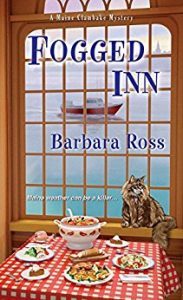 I promised examples. First, Barbara Ross’s excellent mystery FOGGED INN. EXTERNAL GMC: Julia, the heroine sleuth, wants to solve the murder of the man found in her restaurant’s walk-in cooler because somehow she’s at the center of the investigation and the murder has invaded her personal space, but the police have a different view of the case, thus complicating the mess. INTERNAL GMC: She wants to commit long-term to her boyfriend Chris by living together because she loves him, but her long-standing trust issues create tension between the two.
I promised examples. First, Barbara Ross’s excellent mystery FOGGED INN. EXTERNAL GMC: Julia, the heroine sleuth, wants to solve the murder of the man found in her restaurant’s walk-in cooler because somehow she’s at the center of the investigation and the murder has invaded her personal space, but the police have a different view of the case, thus complicating the mess. INTERNAL GMC: She wants to commit long-term to her boyfriend Chris by living together because she loves him, but her long-standing trust issues create tension between the two.
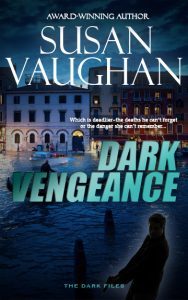 Next, my recent romantic suspense DARK VENGEANCE. EXTERNAL GMC: The hero Jack, a government officer, wants to locate an international smuggler, because the smuggler has stolen uranium for sale on the black market, but Sophie, the woman who may know the smuggler’s hideout, can’t remember the past, crucial three weeks. INTERNAL GMC: Jack wants revenge on the smuggler because the man had Jack’s wife and son murdered and he blames himself for endangering them, but punishing himself with his single-minded pursuit of vengeance means endangering Sophie and he could lose her like he lost his family.
Next, my recent romantic suspense DARK VENGEANCE. EXTERNAL GMC: The hero Jack, a government officer, wants to locate an international smuggler, because the smuggler has stolen uranium for sale on the black market, but Sophie, the woman who may know the smuggler’s hideout, can’t remember the past, crucial three weeks. INTERNAL GMC: Jack wants revenge on the smuggler because the man had Jack’s wife and son murdered and he blames himself for endangering them, but punishing himself with his single-minded pursuit of vengeance means endangering Sophie and he could lose her like he lost his family.
Generally, authors don’t spell this out for readers so directly, especially the internal GMC. For me as an author, the GMC statements are tools in my toolbox as I write. The GMCs, both external and internal, are shown in scenes with action and dialogue as well as in characters’ thoughts. In some action-adventure novels and movies, characters may have only external goals, motivations, and conflicts. James Bond comes to mind. But in a complex novel, as the story progresses, the challenges and conflicts characters face, along with character relationships, impact and influence both the plot developments and the characters. GMCs can change, either dramatically or subtly.
Working with character goal, motivation, and conflict for the novels I’ve written has not spoiled my enjoyment of reading novels. My hope is that this post will not reduce your reading pleasure either, but instead will inform and enhance your fiction reading. My library audience asked tons of questions, so I’m looking forward to yours!
May 14, 2017
There are so many ways to tell a good story
I spend a lot of time scrolling through the offerings on Netflix, Hulu, Amazon Prime, etc. looking for just the right thing to watch. I’m often in the mood for true crime documentary, and I feel sometimes like I’ve watched all the goods ones as I bypass countless reality TV re-enactment-type offerings that I just know aren’t going to give me what I want.
Last night I was lucky enough to choose right.

A scene from “Tower,” the rotoscoped documentary about the 1966 University of Texas mass shooting.
I’d read a review of Tower in the Boston Globe months ago, and it intrigued me. The documentary is about a topic I’ve always had a fascination with — the University of Texas Aug. 1, 1966, mass shooting. But this documentary was different, and I wondered if I’d like it. I’m not a fan of re-enactments. And I really have to be sold on animation, and this uses archival footage combined with what’s known as rotoscoping (thanks to Ty Burr of the Boston Globe, or I’d never know what to call that.) It’s when live actors are used, then are animated over (not the technical description, I know!). You’ve seen it on commercials and some other places.
But the subject matter, combined with my memory of Burr’s review, made me click on it.
I was not disappointed. The documentary uses eyewitness accounts to tell the story, and the combination of the rotoscoping with the real footage is riveting.
I realized watching it that I was way past tired of documentaries with talking heads telling a story they weren’t there for (those ones with celebrities telling you what you just saw on film? Quickest way to get me to turn one off). Ken Burns has given a lot to storytelling, but I can only take so many jangling banjos, sepia-toned photos (which I’m frequently not sure are of the actual subject matter, or are just used to capture the spirit and no one bothers to say we’re not looking at the same thing that’s being talked about). And did I mention talking heads?
“Tower” beat any true-crime documentary I’ve seen recently, hands-down, for dramatic tension. I even forgot in some ways I was watching animation, while at the same time I marveled at just how cool the animation combined with the real footage is. The fact that I knew the details and how it ended didn’t take away from the drama at all, which is saying a lot.
I won’t spoil it, but I’ll let Burr tell you, from his review, one of the best features of this new and exciting type of storytelling:
“There’s a moment about three-quarters of the way through ‘Tower’ that took my breath away — and I was already holding my breath. I won’t tell you what it is, because when you see Keith Maitland’s bravura documentary, you’ll know. All I’ll say is that things suddenly get real.”
He wasn’t kidding. I had the exact same reaction. And, as Burr said, you’ll know it when it hits you.
We live in an age when there are so many new and exciting ways to tell stories. This goes for a lot of things — I’ve become an obsessive podcast listener, particularly of “Casefile,” in which a mostly impassive Australian narrator (we never learn his name) does some really in-depth reporting on some of the more horrific crimes of our lifetime. Hell, before “Serial,” I didn’t even know what a podcast was. After “Serial,” I still avoided them. (I like listening to MUSIC DAMMIT!) But now I’m hooked enough to even have my own.
I sometimes hear authors (none of the ones who blog here, readers!) gripe about all the technology, the social media, the things that distract potential readers and may “take away” from the desire of people to read books. It was the same tune in the newspaper biz when things started going downhill about 10 years ago and many lamented the digital age would make newspapers vanish forever.
I felt about newspapers then, and “book writing” now, that there will always be a need for storytelling and people who can tell stories. How lucky we are to be here, now, when the possibilities are endless. Newspapers can put that court document, or video, online and enhance the story. Authors can share so much of their experience and inspiration through everything from Twitter and Instagram to their Facebook pages and websites, to things like this blog. And even podcasts, if they want to.
I had an opportunity recently to be part of a great online writing series, Short & Helpful Online Writer Workshops, which offers video courses on 12 different writing topics, taught by authors. Because, apparently, I did a nice job with some heavy flashback features in my most recent Bernie O’Dea mystery, “No News is Bad News,” I was asked to narrate the backstory and flashback segment. The whole thing is pretty cool and way beyond resources available to writers when I was trying to figure out how to make this work.
When I see a documentary — or hear a podcast, or read a book — that’s really cool, it gives me total joy. I love things that get into my head, make me think, and engage me in a way that’s hard to do with all the noise out there.
“Tower” made me think, not for the first time, how lucky we are to be in an age where there are so many new ways to tell stories, and creative people aren’t afraid to go out on a limb to do it.
There’s nothing like a good story and good storytelling, so get out there and enjoy it.
EVENT:

Check me out 6:30 p.m. Tuesday, May 16, at Lithgow Public Library in Augusta, Maine.
CHECK OUT MY special brand of storytelling at 6:30 p.m. Tuesday, May 16, (tomorrow if you’re reading this the day it posts)
when I bring my traveling slide show (yes I do!) to Lithgow Public Library in Augusta, Maine, the library responsible for making me the the mystery writer that I am. Books will be available to buy and I’ll sign whatever you have, but mostly I’d just like to see you there!
Maureen Milliken is the author of the Bernie O’Dea mystery series. Follow her on Twitter at@mmilliken47 and like her Facebook page at Maureen Milliken mysteries. Sign up for email updates at maureenmilliken.com. She hosts the podcast Crime&Stuff with her sister Rebecca Milliken.


